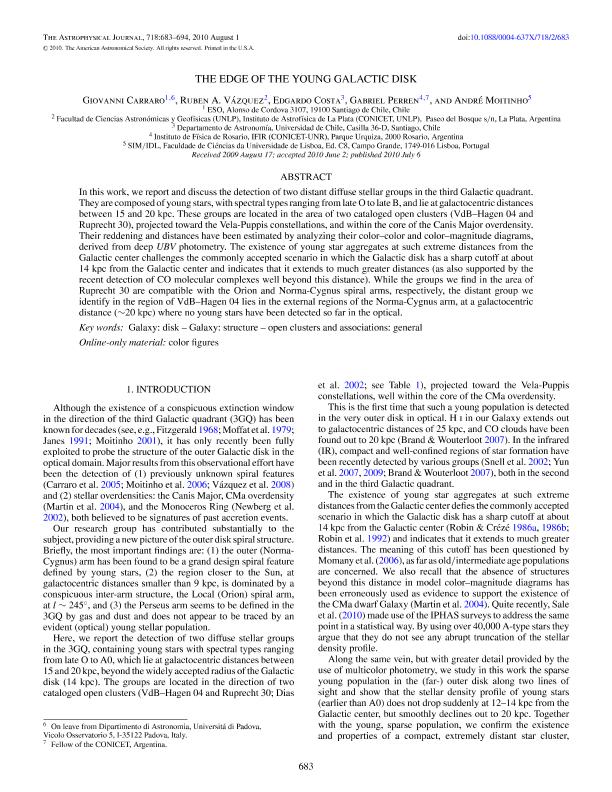Mostrar el registro sencillo del ítem
dc.contributor.author
Carraro, Giovanni
dc.contributor.author
Vazquez, Ruben Angel

dc.contributor.author
Costa, Edgardo
dc.contributor.author
Perren, Gabriel Ignacio

dc.contributor.author
Moitinho, André
dc.date.available
2016-12-16T17:39:44Z
dc.date.issued
2010-08
dc.identifier.citation
Carraro, Giovanni; Vazquez, Ruben Angel; Costa, Edgardo; Perren, Gabriel Ignacio; Moitinho, André; The edge of the young Galactic disk; Iop Publishing; Astrophysical Journal; 718; 2; 8-2010; 683-694
dc.identifier.issn
0004-637X
dc.identifier.uri
http://hdl.handle.net/11336/9582
dc.description.abstract
In this work, we report and discuss the detection of two distant diffuse stellar groups in the third Galactic quadrant. They are composed of young stars, with spectral types ranging from late O to late B, and lie at galactocentric distances between 15 and 20 kpc. These groups are located in the area of two cataloged open clusters (VdB-Hagen 04 and Ruprecht 30), projected toward the Vela-Puppis constellations, and within the core of the Canis Major overdensity. Their reddening and distances have been estimated by analyzing their color-color and color-magnitude diagrams, derived from deep UBV photometry. The existence of young star aggregates at such extreme distances from the Galactic center challenges the commonly accepted scenario in which the Galactic disk has a sharp cutoff at about 14 kpc from the Galactic center and indicates that it extends to much greater distances (as also supported by the recent detection of CO molecular complexes well beyond this distance). While the groups we find in the area of Ruprecht 30 are compatible with the Orion and Norma-Cygnus spiral arms, respectively, the distant group we identify in the region of VdB-Hagen 04 lies in the external regions of the Norma-Cygnus arm, at a galactocentric distance (~20 kpc) where no young stars have been detected so far in the optical.
dc.format
application/pdf
dc.language.iso
eng
dc.publisher
Iop Publishing

dc.rights
info:eu-repo/semantics/openAccess
dc.rights.uri
https://creativecommons.org/licenses/by-nc-sa/2.5/ar/
dc.subject
Galaxy
dc.subject
Galactic Disk
dc.subject
Young Stars
dc.subject.classification
Astronomía

dc.subject.classification
Ciencias Físicas

dc.subject.classification
CIENCIAS NATURALES Y EXACTAS

dc.title
The edge of the young Galactic disk
dc.type
info:eu-repo/semantics/article
dc.type
info:ar-repo/semantics/artículo
dc.type
info:eu-repo/semantics/publishedVersion
dc.date.updated
2016-12-14T15:26:18Z
dc.journal.volume
718
dc.journal.number
2
dc.journal.pagination
683-694
dc.journal.pais
Reino Unido

dc.conicet.avisoEditorial
Archivo subido por el curador
dc.description.fil
Fil: Carraro, Giovanni. European Southern Observatory; Chile
dc.description.fil
Fil: Vazquez, Ruben Angel. Consejo Nacional de Investigaciones Científicas y Técnicas. Centro Científico Tecnológico La Plata. Instituto de Astrofísica de La Plata; Argentina
dc.description.fil
Fil: Costa, Edgardo. Universidad de Chile. Departamento de astronomía; Chile
dc.description.fil
Fil: Perren, Gabriel Ignacio. Consejo Nacional de Investigaciones Científicas y Técnicas. Centro Científico Tecnológico Rosario. Instituto de Física de Rosario (i); Argentina
dc.description.fil
Fil: Moitinho, André. Universidade de Lisboa. Faculdade de Ciéncias; Portugal
dc.journal.title
Astrophysical Journal

dc.relation.alternativeid
info:eu-repo/semantics/altIdentifier/url/http://iopscience.iop.org/article/10.1088/0004-637X/718/2/683/meta
dc.relation.alternativeid
info:eu-repo/semantics/altIdentifier/doi/http://dx.doi.org/doi:10.1088/0004-637X/718/2/683
Archivos asociados
